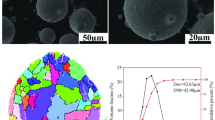Abstract
Investment casting (IC) ceramic shells are mostly impervious in nature which causes gas porosity defects in the castings. The present research work emphasizes on additional increase of ceramic shell’s porosity (23%) and permeability (7%) by drilling micro holes on it using ultra-sonic machining (USM) process. It was established that the casting porosity of Al-7wt.%Si alloy reduced by 17.3% and its tensile strength increased by 8.7% as compared to those obtained from conventional polymer modified ceramic shells (PMCS). A little damage to the inner primary layer of the brittle ceramic shell was observed that occurred due to micro-drilling process, which later produced spikes on casting. However, these spikes were easily removed from the cast parts by minor finishing operation.
Similar content being viewed by others
Data Availability
Not applicable.
References
Beeley PR, Smart RF (1995) In: Investment casting. 1st edn, CRC Press, Institute of Materials, London
Pattnaik SR, Karunakar DB, Jha PK (2012) Developments in investment casting process- a review. J Mater Process Technol 212:2332–2348
Pattnaik SR (2017) Influence of saw dust on the properties of the ceramic shell used in investment casting process. Int J Adv Manuf Technol 93:691–707
Pattnaik SR, Sutar MK (2021) Effect of saw dust content on slurry rheology and mechanical properties of the investment casting ceramic Shell. Int J Metal Cast 15:470–487
Ott D, Raub CJ, Rapson WS (1985) Investment casting of gold jewellery porosity in castings, its causes and prevention. Gold Bull 18(3):98–108
Jones S, Leyland S (1995) The use of conductivity as a means of assessing the extent of wet back in an investment casting mould. Proc of the 22nd BICTA, Bath, UK
Jones S, Marquis PM (1995) Role of silica binders in investment casting. Brit Ceram T 94:68–73
Li Y, Liu X, Lu K (2019) Preparation of fiber-reinforced shell by airflow placement Fiber Technology For Investment Casting. Int J Metal Cast 13:979–986
Lu K, Duan Z, Liu X, Li Y (2019) Effects of fibre length and mixing routes on fibre reinforced shell for investment casting. Ceram Int 45(6):6925–6930
Lu K, Liu X, Duan Z (2019) Effect of firing temperature and time on hybrid fiber-reinforced Shell for investment casting. Int J Metal Cast 13:666–673
Pattnaik SR (2017) An investigation on enhancing ceramic shell properties using naturally available additives. Int J Adv Manuf Technol 91:3061–3078
Sindhu D, Thakur L, Chandna P (2019) Multi-objective optimization of rotary ultrasonic machining parameters for quartz glass using Taguchi-Grey relational analysis (GRA). Silicon 11:2033–2044
Kumar V, Singh H (2019) Rotary ultrasonic drilling of silica glass BK-7: microstructural investigation and process optimization through TOPSIS. Silicon 11:471–485
Sindhu D, Thakur L, Chandna P (2020) Parameter optimization of rotary ultrasonic machining on quartz glass using response surface methodology (RSM). Silicon 12:629–643
Liu JW, Baek DK, Ko TJ (2014) Chipping minimization in drilling ceramic materials with rotary ultrasonic machining. Int J Adv Manuf Technol 72:1527–1535
Nath C, Lim GC, Zheng HY (2012) Influence of the material removal mechanisms on hole integrity in ultrasonic machining of structural ceramics. Ultrasonics 52(5):605–613
Haashir A, Debnath T, Patowari PK (2019) A comparative assessment of micro drilling in boron carbide using ultrasonic machining. Mater Manuf Process 35(2):1–9
Reddy PS, Kesavan R, Ramnath BV (2018) Investigation of mechanical properties of aluminium 6061-silicon carbide, boron carbide metal matrix composite. Silicon 10:495–502
Monroe R (2005) Porosity in castings. AFS Transactions, Schaumburg, USA
Sabau AS, Viswanathan S (2008) Porosity prediction in aluminum A356 alloy castings. Metals and Ceramics Division, Oak Ridge National Laboratory
Abdulwahab M, Madugu IA, Yaro SA, Popoola API (2012) Effects of temper conditions and step-quenching-ageing on the hardness characteristics and yield strength of A356.0-type Al-Si-Mg alloy. Silicon 4:137–143
Mugica GW, Tovio DO, Cuyas JC, González AC (2004) Effect of porosity on the tensile properties of low ductility aluminum alloys. Mater Res 7(2):221–229
Kumar S, Dvivedi A (2019) On machining of hard and brittle materials using rotary tool micro-ultrasonic drilling process. Mater Manuf Process 34:736–748
Kumar V, Singh H (2019) Optimization of rotary ultrasonic drilling of optical glass using Taguchi method and utility approach. Eng Sci Technol Int J 22:956–965
Popli D, Gupta M (2018) A chipping reduction approach in rotary ultrasonic machining of advance ceramic. Mater Today Proc 5:6329–6338
Acknowledgments
The authors would like to thank Dr. Kishore Debnath for his help in USM.
Funding
Authors are thankful to Bee Chems India Pvt. Ltd., Kanpur for supplying the slurry materials for constructing the ceramic shells.
Author information
Authors and Affiliations
Contributions
The corresponding author has conducted the experimentation and the second author has done all editing of text and figures, and critically revised the manuscript before submission.
Corresponding author
Ethics declarations
The present research work complies with ethical standard.
Consent to Participate
Not applicable.
Consent for Publication
The authors give their consent for publication.
Conflict of Interest
There is no conflict of interest for the present work.
Additional information
Publisher’s Note
Springer Nature remains neutral with regard to jurisdictional claims in published maps and institutional affiliations.
Rights and permissions
About this article
Cite this article
Pattnaik, S., Sutar, M.K. Influence of Ultra-Sonic Drilling on Colloidal Silica Based Ceramic Moulds for Investment Casting. Silicon 14, 3981–3992 (2022). https://doi.org/10.1007/s12633-021-01166-5
Received:
Accepted:
Published:
Issue Date:
DOI: https://doi.org/10.1007/s12633-021-01166-5




